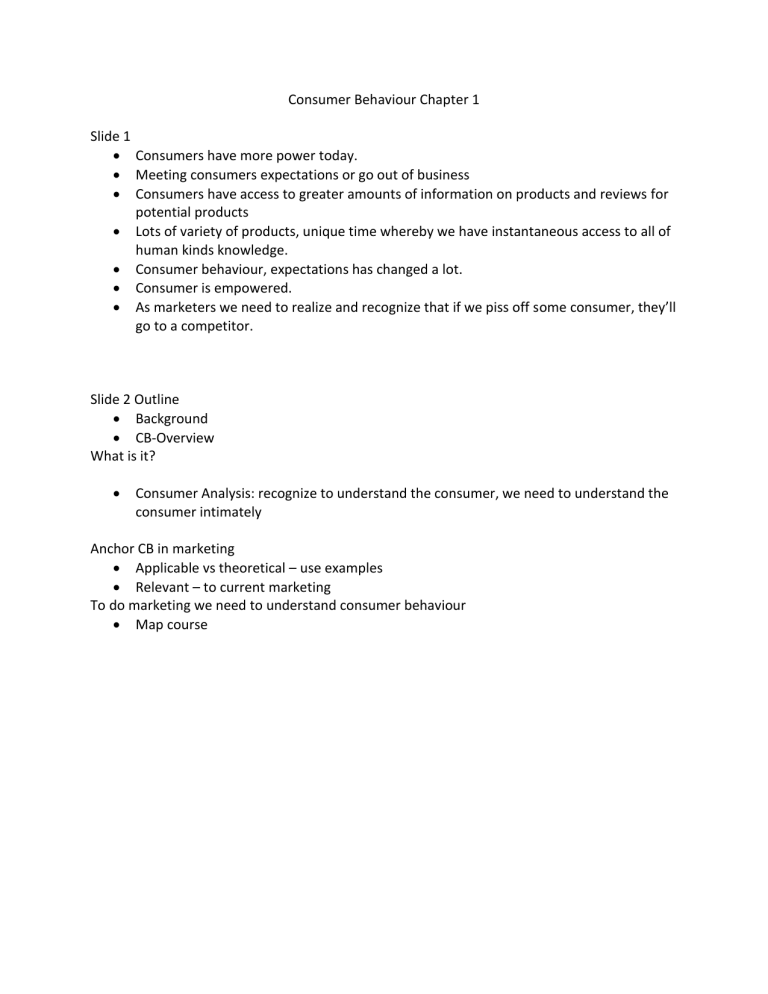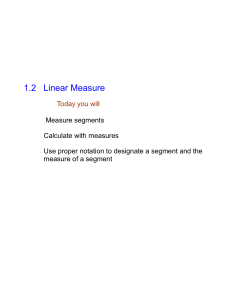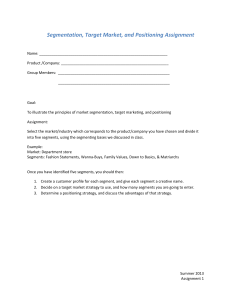
Consumer Behaviour Chapter 1 Slide 1 Consumers have more power today. Meeting consumers expectations or go out of business Consumers have access to greater amounts of information on products and reviews for potential products Lots of variety of products, unique time whereby we have instantaneous access to all of human kinds knowledge. Consumer behaviour, expectations has changed a lot. Consumer is empowered. As marketers we need to realize and recognize that if we piss off some consumer, they’ll go to a competitor. Slide 2 Outline Background CB-Overview What is it? Consumer Analysis: recognize to understand the consumer, we need to understand the consumer intimately Anchor CB in marketing Applicable vs theoretical – use examples Relevant – to current marketing To do marketing we need to understand consumer behaviour Map course Slide 3 Background What is marketing? ANS marketing we recognize it’s a broad field, boil it all down to a core nugget, the core is called the marketing concept Marketing concept: Meeting the needs and wants of the customer profitably. How do we fulfil this marketing concept Market orientation: being the operationization of the marketing concept. (How do we do the marketing concept), 3 stage kind of process- marketing orientation 1) getting market place information (consumer research) 2) Bringing it into the firm and disseminating it (moving it around, R&D guys, leadership etc) 3) reacting to it CB: Balance in approach Slide 4 What is Consumer Behaviour A multitude of form of definitions CB is a whole process, not a static concept, its intimately related to consumers needs and wants, also CB it incorpates an approach to pre-purchase, the actual purchase and to post purchase, and ultimate disposal. CB spans all of that. Consumer choice / Decision Process Core nugget of CB, is about decision making process and all the things that are involved in that 1) Problem Recognition: Figure out problem we have 2) Search: Search for information 3) Evaluation: whats our best solution 4) Decision: Make that purchase, where do we go online, In-store? 5) Post-purchase behaviour Mothersbaugh et al. 2022 p.6 “Customer-Centrism” = Critical Slide 5 Consumer choice / Decision Process Core nugget of CB, is about decision making process and all the things that are involved in that Problem Recogntion Search Evalaution Decision Post-purchase behaviour Slide 6 CB and MKTG Strat CB Tied to a broader domain of marketing, to do marketing we need to understand CB Connected Mktg Strat: Influence the behavioural setting such that the probability the consumer will purchase our desired product is enhanced and the probability they’ll engage in another behaviour Is decrease. Influence the behavioural setting: For example, signage (way price is presented), make consumer behave in a certain way, or inside the retail environment how the consumer acts in that place, Costco wont see any signage, so they can look around and brings on a sense of discovery or their inventory moves around, feeds into the notion of discovery. Influence a behavioural setting increasing desirability of purchasing products. Give consumer big shopping carts, tendency to fill the cart up. Con rft Sched: Control reinforcement and scheduling in order to achieve our goals Means rewarding the consumer with something, loyalty points, enhance same brand purchasing, enhance loyalty and more purchasers, great volumes of purchases, rewarding the consumer with a sale, for example. DO ALL THIS BY understand the consumer Slide 7 Customer Analysis Develop an overall marketing strategy, 1) Objectives: What we want to accomplish 2) Customer Targets: who to target 3) Competitor targets: who are competitors, strength and weaknesses 4) Core Strategy: What is our core marketing strategy, we can have our core marketing strategy based on growth or a positioning strategy. 5) Implementation: marketing mix (product, promotion, price, place – CRM- Customer Relationship Management) by arranging our 4 P framework we do the above. Organize all 4 P’s in order to impose the above How do we do customer targeting, do that by consumer behaviour, how we effect customer Targets Then Ask us the 5 W’s, who are the consumer, where do they go 1) Who - are our consumers. Slide 8 1) Who are the Customers Understanding the consumer is a starting point to understand who are our customers Who are our current customers, who are our potential customers, who are our previous customers and why did they leave us and who are the competitor customers? MUST understand the customer, we understand consumers and learn about them by engaging in market research (customer research) Customers? Who? -> segmentation: Do this through segmentation: Segmentation is breaking down that mass market into identifiable groups of consumers Slide 9 Market Segmentation We want to do this because as business ppl we cant be all things to all people, not everyone wants a big mac, or a Ford truck What? Tailor Marketing: Tailor our marketing efforts to those particular consumers (segments of consumer’s) Efficiency and Effectiveness, need to build this into our marketing strategies, how well we can do something’s, effectives is whether or not we do it Segmentation vs choosing segments: Break mass market into groups / segments, then select several segments to focus our marketing efforts. That segment is then known as our target market Slide 10 Market Segments Groups of customers that have similar needs and wants, typically seek similar benefits Similar buying patterns, captures the essence of what a segment is all about Target customers (pieces you want to target)*** Slide 11 Ways to Segment Geographic: Location of consumers, regions of country, countries, North vs south side of a street, very broad or specific. Demographic: university students (educational level), income, single mothers 30-40) Psychographic: two major things, lifestyle and Personality, Lifestyle about activities a consumers engages in throughout time. Behavioural: Frequency of purchase, where they go Slide 12 A composite Approach Combine E.G -auto makers 25-44 age segment and “off-road driving” Demographic and behavioural Slide 13 Requirements of effective segmentations Distinctive in the sense of the segments is segmented Measurable: Marketing efforts, has to be large enough or can it grow more in the future Substantial: Accessible: Is our segment accessible Slide 14 Criteria -satisfied by segmentation Homo. Within, Hetero. Between Size Growth Competitive position: Can we adopt a competitive position within the segment, is it already saturated, can we even compete? Identifiable and Accessible Cost: Segment in Northern Canada would cost a lot more money to access them. Compatibility: Strategic compatibility, whatever segment we choose should be consistent with our brand and marketing strategy. EG) Would Apple go after an aged demographic aged 80 years + no they would not, not their branding strategy, more froward looking brand and young Slide 15 Monstanto’s “Round Up” Industrial segment for farmers and a consumer segment as well, 2 major segmentation groups Also used for farmers as well. After Winter they will blanket the field in round up and kill all the weeds and a short half-life, so seed can be put in pretty quickly after. Farm Market: 8.99 /litre, Add 80 litres of water and applied price is .10 cents a litre Consumer Market: 10 bucks a litre, add no water, applied price (10 bucks a litre) Scotts = MKTG agent For each segment we have a ubique 4 P configuration dedicated to each one of those two Segments. Slide 16 The New Product Consumer Adoption Categories Bell shaped curve Innovators: 2.5% Folks who love practicing option leadership, love being go to ppl for new technology, not price sensitive, camp out in front of apple store before the launch of IPAD Early adopters: 13.5% Early Majority: 34% Late majority: 34% Laggards: 16%, Avoid new technology at all costs, use old phones in home Focus in on one or more of these segments Slide 17 Alternative Targeting Strategies Unfocused strategy, no! Focussed strategy: Do this one figure out the segment you want Slide 18 2) Why do customers Buy? Trigger: NEED = ideal vs actual state. Laptop dies, that’s the actual situation don’t have a laptop, triggers a need that needs to be fulfilled. Motivation- benefits: Energizing force to satisfy that need. Consumers are seeking benefits from a product not just attributes Link: Attributes, We need to link benefits to consumers from the attributes (each segment seeking their own benefits) 1st step Need recognition Maslow Consumers don’t buy attributes, consumers buy benefits EXAM Seeking resolution to that need. Slide 19 Features & Benefits “translate attributes (features) onto benefits. All benefits are matched to the feature A tire, don’t care about composition of the rubber and read size (attributes), im buying a comfortable ride, smooth ride, snow and mud handling, stopping distance (benefits youre buying). Need to highlight to the consumer the benefits Slide 20 3) How do Consumers Make Purchase Decisions? Info Search Internal and external sources, search for info, starts internal then goes external (ask family members) Categorization Evoked / consideration set: My truck blew up do I consider a Ram 1500 or Toyota Tundra or ford raptor, then we pick out of that set Evaluation Multi-attribute model Slide 21 Continued, How do Consumers Make Purchase Decisions Post Purchase Evaluation: 1) Assessment of satisfaction, based off of satisfaction am I going to tell people about it? 2) Word of mouth 3. Cognitive Dissonance: Tense about buying a new house for 500k, anxiety that arises Slide 22 How do Consumers Make Purchase Decisions? External Influences Key influences include” Group (soc Inf) Product class MKTG Situational Slide 23 4) Where and (5) when do customers buy? Where? Wait until When? Wait until things go on sale, black Friday? Slide 24 Understanding the consumer – key to analyzing markets The Consumer is central Sounds easy… but its not Segmentation- critical importance to marketing Learning CB is instrumental Slide 25 Slide 26 Slide 27 Slide 28 Slide 29 Slide 30 Slide Slide Slide Slide Slide Slide




